Ear cartilage rhinoplasty is becoming a popular choice among international visitors coming to Vietnam for cosmetic surgery. This method uses autologous cartilage from the ear rim to create a natural, harmonious nose shape without concerns about allergies or implant visibility. With advanced technology and the skilled hands of Vietnamese surgeons, you can achieve a refined, well-defined nose in just one procedure. Let’s explore this technique in detail to make your beauty journey in Vietnam complete and worry-free.
What is ear cartilage rhinoplasty?
Ear cartilage rhinoplasty is a cosmetic technique that uses autologous cartilage taken from the ear (usually from the area behind the ear or the conchal cartilage) to lift the nasal bridge, reshape the tip, or cover the nose tip.
Unlike rhinoplasty with artificial implants, ear cartilage is 100% natural material from your own body, ensuring full biocompatibility and minimizing risks of allergy, implant visibility, or redness at the tip.
This method is especially suitable for creating a soft, natural Asian-style nose shape, giving a refined high bridge and rounded tip while maintaining harmony with the facial features.

Who is rhinoplasty with ear cartilage for?
Ear cartilage rhinoplasty is a safe and highly aesthetic beauty solution, but it is most suitable for those who:
- Want a natural, soft nose shape: Ear cartilage has great elasticity, ideal for creating a rounded tip and refined Asian-style nasal bridge.
- Have thin nasal skin or a weak nose tip: Autologous cartilage helps cover and protect the tip, preventing redness or implant visibility common with artificial materials.
- Previously had an unsuccessful rhinoplasty: Suitable for nose tip correction, alar reduction, or fixing complications.
- Are concerned about allergic reactions to synthetic implants: Ear cartilage is 100% autologous, eliminating the risk of immune response.
- International visitors seeking a safe, minimally invasive option: The procedure is quick, recovery takes about 5–7 days, and it easily combines with a beauty trip in Vietnam.
If you desire a harmonious, long-lasting, and natural-looking nose, this is the ideal choice.

How much does ear cartilage rhinoplasty cost?
The cost of ear cartilage rhinoplasty in Vietnam typically ranges from 25 to 70 million VND (approximately 1,000 – 3,000 USD), depending on several key factors that ensure the most natural and safe results for international visitors like you. Some of the main factors affecting the price include the complexity of the procedure, the surgeon’s expertise, and the reputation of the clinic.
In short, the higher the cost of rhinoplasty surgery, the more likely you are to receive results that truly match your expectations in both quality and aesthetics. Therefore, avoid choosing solely based on price and take time to make the best decision for your nose enhancement journey.
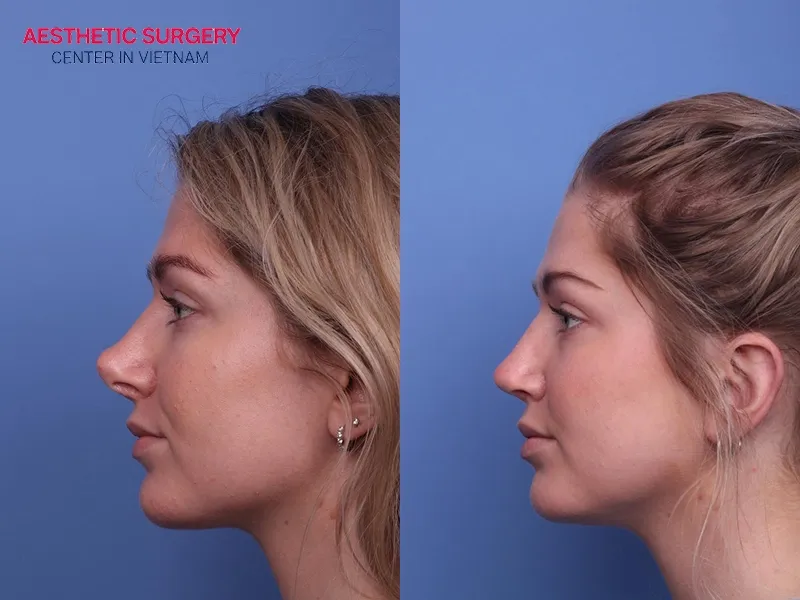
Rhinoplasty procedure using ear cartilage
When learning about ear cartilage rhinoplasty, understanding the procedure helps you clearly visualize what you will experience and mentally prepare yourself. This also plays an important role in choosing a reputable and high-quality clinic.
The ear cartilage rhinoplasty procedure in Vietnam follows international standards and typically includes 5 main steps:
Step 1: Consultation & 3D design
The surgeon measures your facial proportions and uses Vectra 3D software to simulate the expected nose shape so you can preview the result.
Step 2: Health check
Includes blood tests and X-ray of the ear cartilage.
Step 3: Anesthesia
Local anesthesia is applied to the ear and nose areas, combined with mild sedation (no need for general anesthesia).
Step 4: Ear cartilage harvesting
The surgeon makes a small incision behind the ear (hidden in the natural fold) to avoid visible scars. About 3–5 mm of conchal cartilage is taken without affecting hearing or ear shape.
Step 5: Cartilage shaping
The harvested ear cartilage is finely trimmed, rolled, or layered to prepare for:
- Nasal bridge augmentation: Combine ear cartilage with an implant (if additional height is needed).
- Tip coverage: Place a “shield graft” or “cap graft” to protect the nasal tip.
- Alar correction: Use a “batten graft” if the alar cartilage is weak.
Step 6: Cartilage placement and fixation
Insert the prepared cartilage into the nasal pocket through a closed or small open incision. Then fix it with 5-0 absorbable sutures.
Step 7: Wound closure & shaping splint
Perform aesthetic suturing and apply an external thermoplastic splint for 5–7 days. No nasal packing is needed (except in cases of alar reduction).
Step 8: Postoperative care
After the procedure, since only local anesthesia is used, you will be fully awake with minimal headache or nausea. You can return to your hotel to rest and come back for follow-up on day 3 and day 7 for splint removal.
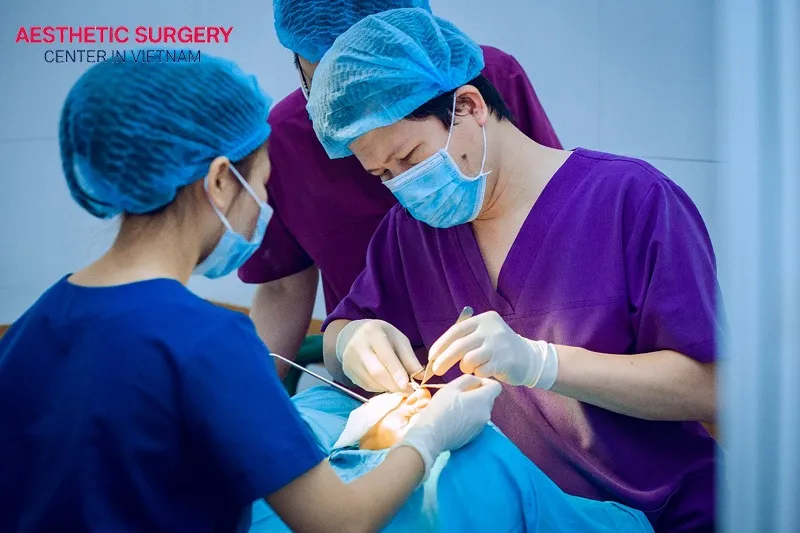
Recovery process after rhinoplasty with ear cartilage
If you choose a reputable and qualified clinic with a medically standardized procedure, here is exactly what you will experience after the surgery:
Day 1–2: Mild swelling stage, complete rest
- Right after surgery, you will be awake with slight numbness around the nose and behind the ears. Mild swelling around the eyes (if any) and tightness at the nasal tip are normal.
- Care: Apply a cold compress for 15 minutes each time, 4–5 times a day (use a cold gel pack wrapped in a thin towel, avoid getting the dressing wet). Take painkillers and antibiotics as prescribed. Sleep with your head elevated 30–45°, avoid bending forward. Eat soft, cool foods (soup, thin porridge), and strictly avoid smoking or alcohol.
Day 3–5: Noticeable swelling reduction, ear suture removal
- Swelling has decreased by about 50–60%, and bruising around the nose has faded to a light yellow color. The ear area where cartilage was taken has also recovered significantly.
- Care: Continue cold compresses until day 3, then switch to gentle warm compresses to help dissolve bruising. Clean your face with saline solution and gently wipe around the dressing. Avoid wearing glasses or tight hats. Visit the clinic on day 3 for nasal cleaning and ear cartilage check-up.
Ngày 6 – 7: Splint removal, initial nose shaping
- The surgeon will remove the external thermoplastic splint, revealing a higher, more refined nasal bridge and a rounded, neat tip. However, the nose is still about 20–30% swollen, so the visible shape is not yet the final result.
- Care: Continue cleaning the nose with saline solution twice a day (using a clean cotton swab). Apply scar recovery cream to the incision behind the ear. Avoid strong impacts and do not blow your nose forcefully. You may wear light makeup (avoiding the nose area) and wash your hair normally, but avoid steam or sauna.
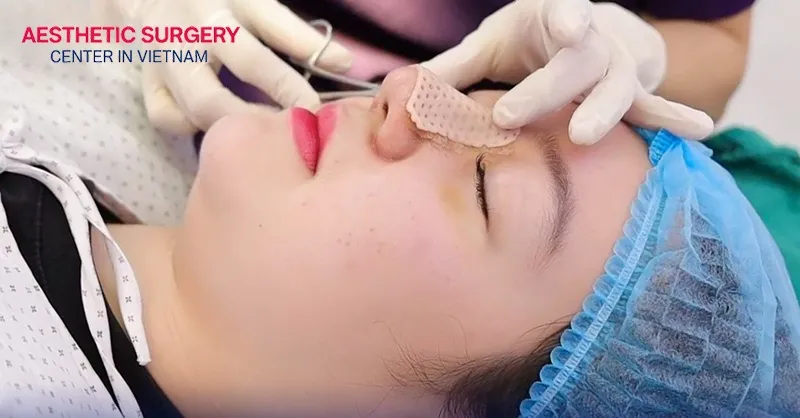
Week 2–4: 80% recovery, almost normal daily activities
- The nose will gradually become softer, and swelling will nearly disappear. The incision behind the ear heals into a light pink scar hidden within the natural fold.
- Care: Gently massage the nasal bridge as instructed by your surgeon (starting from week 2) to help the cartilage settle firmly. Use SPF50+ sunscreen when going outside. Avoid intense gym workouts, swimming, and spicy or hot foods. Get 7–8 hours of sleep and add vitamin C and zinc (orange juice, kiwi) to support collagen production.
Month 2–3: 90% stable results
- At this stage, the nose has fully settled into a natural shape, and the tip feels soft and lifelike. The ear scar has almost completely faded.
- Care: Continue sun protection and gentle massage. You can now start light activities like yoga or jogging! However, don’t skip your routine follow-up appointments at 3 to 6 months to check the stability of the cartilage.
Month 6–12: Permanent results
- This is when you can truly feel your nose has reached 100% natural form, as the ear cartilage has fully integrated with the nasal tissue. You can live, exercise, and wear makeup comfortably. Meanwhile, the ear scar becomes almost invisible.

Ear cartilage rhinoplasty before and after photos
Real results are always the most convincing “living proof.” Below are some before-and-after photos from Ear Cartilage Rhinoplasty cases to help you visualize the outcomes after surgery.
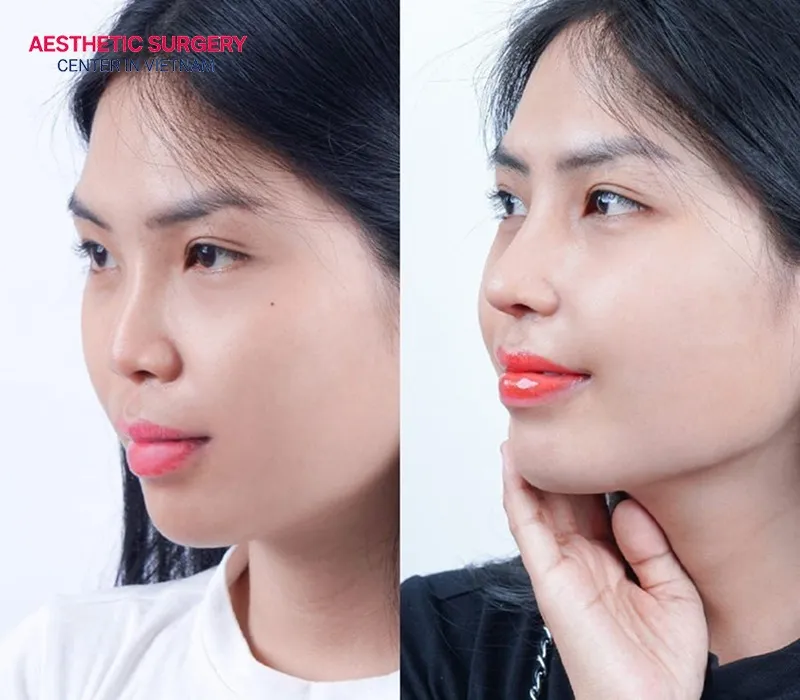
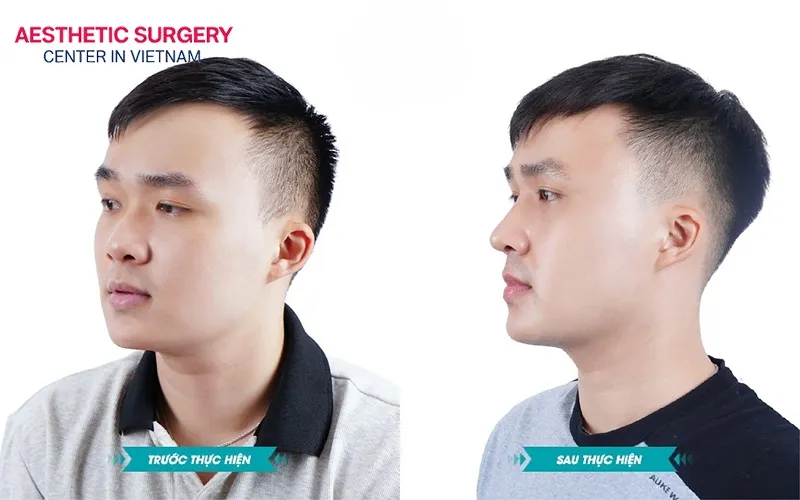


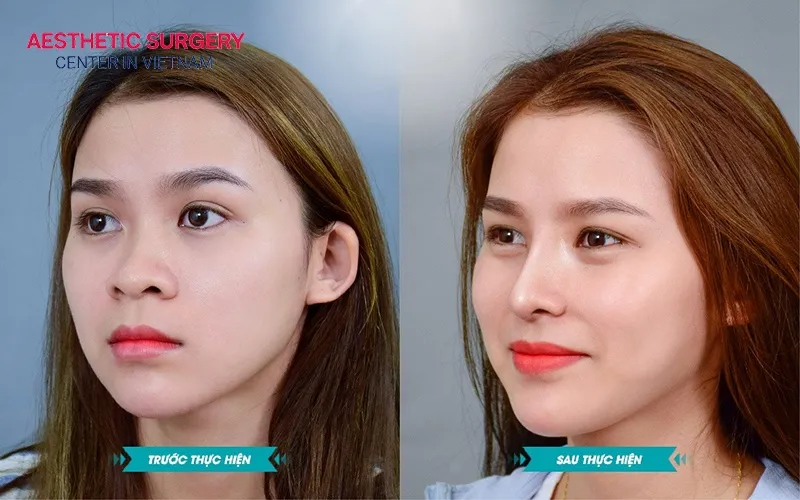
Reputable cartilage rhinoplasty address in Vietnam
Aesthetic Surgery Center is a prestigious beauty destination in Vietnam, the ideal choice for international clients seeking a naturally refined nose shape. With a team of experienced and dedicated surgeons, the center is committed to delivering safe results that perfectly harmonize with Asian facial features.
The center also prioritizes a luxurious, state-of-the-art facility, featuring a sterile JCI-standard operating room and comfortable postoperative recovery suites for complete relaxation. Dedicated customer care specialists are available 24/7 to assist you, from airport pickup and 5-star hotel booking to recovery follow-up. Visit us today to experience the difference!
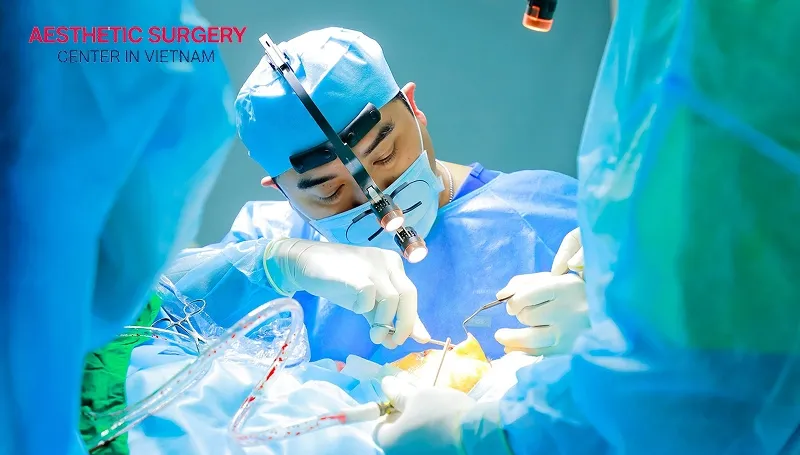
Frequently Asked Questions
Feeling anxious before surgery is completely normal. However, don’t let that worry stop you from enjoying your wonderful experience in Vietnam. Equipping yourself with the right knowledge and insights will help you feel more confident as you begin your transformation journey.
Here are some common questions about Ear Cartilage Rhinoplasty, along with detailed answers for your reference!
Ear cartilage rhinoplasty side effect
Ear cartilage rhinoplasty is a highly safe technique thanks to the use of autologous (self) cartilage. However, similar to any cosmetic surgery, you may still experience some temporary side effects. Let’s take a look at what they are so you can prepare mentally and care properly afterward.
- Mild swelling and bruising may appear around the nose, under the eyes, and slightly spread to the cheeks. This usually peaks after 2–3 days and gradually subsides after 7 days. To reduce swelling and pain, apply cold compresses continuously during the first 48 hours, then switch to warm compresses. Keep your head elevated while sleeping and take anti-swelling medication as prescribed.
- You may feel tightness or soreness when touching the nose and behind the ear. In this case, avoid touching the area and take pain relievers as directed.
- Slight bleeding or yellowish discharge may occur within the first 24–48 hours. Gently clean with sterile gauze and avoid blowing your nose forcefully to prevent irritation of the nasal lining.
- Temporary itching or numbness may also occur due to mild nerve stimulation. Don’t worry — avoid scratching, as this will naturally subside after 2–4 weeks.
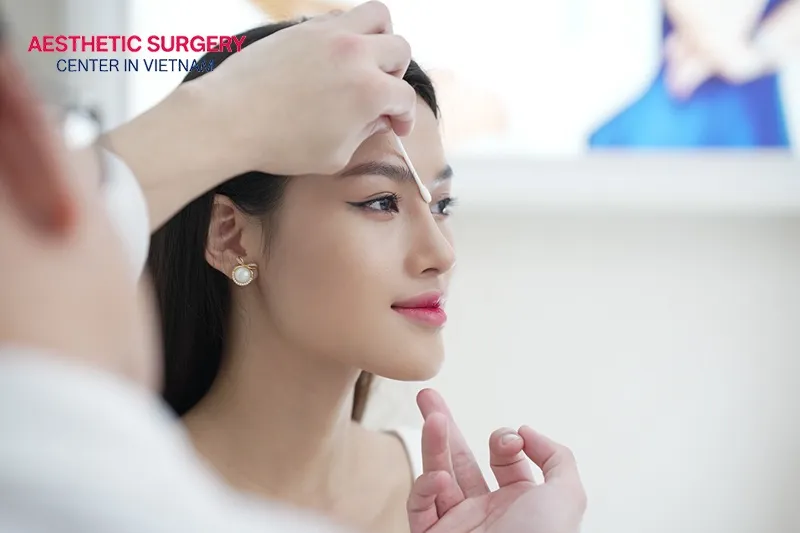
In addition, you may encounter more serious side effects such as:
- Infection around the nose or behind the ear, with redness, swelling, heat, or pus.
- Hypertrophic scar behind the ear.
- Slight cartilage exposure or deviation.
- Nasal tip necrosis in cases of extremely thin skin or poor surgical technique.
- Ear deformity if more than 30% of the conchal cartilage is removed.
These severe complications usually occur only when the procedure is performed at unreliable clinics or when proper postoperative care is not followed. So don’t worry too much!
Is ear cartilage rhinoplasty painful?
The answer to the question “Is ear cartilage rhinoplasty painful?” is no — thanks to local anesthesia combined with mild sedation. This allows you to sleep during the procedure and feel almost nothing.
After surgery, you may experience slight numbness or tightness around the nose and behind the ears, but this discomfort will decrease by about 80% within 24 hours with pain medication.
From day 1 to day 2, you may still feel mild discomfort when touching the area, but not sharp pain.
From day 3 onward, the nose and ear areas will feel almost normal, with only slight sensitivity when pressed firmly.
How long does ear cartilage rhinoplasty take?
The entire ear cartilage rhinoplasty procedure usually takes about 60–90 minutes, including:
- Consultation & 3D imaging (30 minutes)
- Local anesthesia + ear cartilage harvesting (15 minutes)
- Shaping & cartilage placement (30–45 minutes)
- Closure & splint application (10 minutes)
- Recovery: Splint removal after 6–7 days, and you can fly home after 7–10 days.
- Natural results appear at about 90% after 1 month and reach 100% perfection after 6 months, once the ear cartilage fully integrates with the nasal tissue.
Ear cartilage rhinoplasty not only brings a naturally refined and elegant nose shape but also offers a safe and comfortable experience for international clients in Vietnam. With reasonable costs, advanced technology, and attentive care, you can achieve the perfect Asian beauty without worries. Let Aesthetic Surgery Center accompany you, from personalized consultation and JCI-standard surgery to airport transfers and postoperative recovery. Contact us today to receive your customized beauty quote and treatment plan.




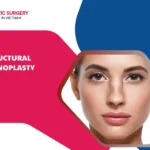







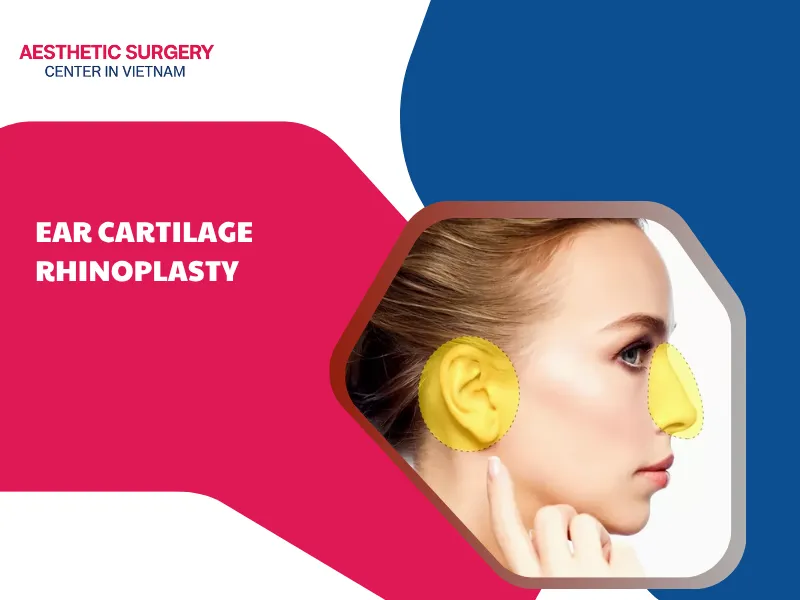







Comment on the post